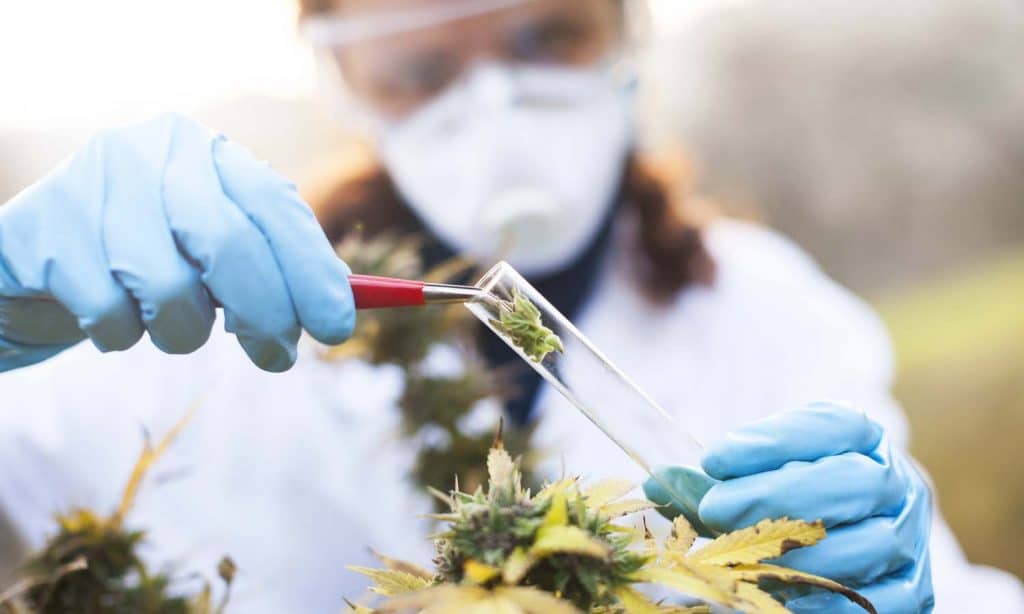As the hemp industry continues with the delta-8 THC craze, another minor cannabinoid is beginning to see market prevalence. THC-O-acetate, commonly referred to as THC-O or ATHC, has also been referred to as the “spiritual cannabinoid,” with some users likening the effect to psilocybin when ingested. Currently, there is a dearth of clinical research regarding efficacy, dosage, and benefits of THC-O.
Preliminary research has indicated that THC-O has the potential for an increased potency of 300% over delta-9 THC, and this increased potency has made it an attractive alternative cannabinoid for the hemp industry seeking lucrative psychoactive material for mass retail sale. At least one patent has been granted covering a process for producing THC-O-acetate. See U.S. Patent No. 10,792,584. It is important to note that the grant of a US patent does not necessarily mean that the patent is valid, as patents are routinely invalidated for prior art or other reasons.
Unlike delta-8 THC, which is a naturally occurring phytocannabinoid in the Cannabis sativa L. plant, THC-O cannot be found naturally in the hemp plant. THC-O is produced only under controlled conditions in a laboratory, a distinction that is important for legal analysis. The resultant material from the completed acetylation process is an incredibly potent THC isolate that presents in the form of a thick, brown liquid. Of concern, prevalent instructions abound on how to synthesize THC-O-acetate from amateur chemists or home enthusiasts in forums ranging from YouTube to Reddit. Conversion processes involve highly volatile solvents, including acetic anhydride, and should only be attempted by qualified professionals in controlled laboratory conditions.
Is THC-O-acetate legal?
Interestingly, THC-O is not specifically scheduled under the federal Controlled Substances Act (“CSA”). This is largely due to the lack of market prevalence at the time the CSA and subsequent amendments were adopted. Donald A. Cooper, a forensic chemist with the Drug Enforcement Administration (“DEA”), has described at least one, isolated encounter of the substance in the field that occurred in 1978. Describing the pharmacological processes required to create THC-O, his characterization recalls the specific process utilized, which was the same process relied on to create heroin from morphine:
- “…ten years ago (1978) an attempt to produce CsA’s from cannabis extracts was encountered in the Jacksonville, Florida area. In this case a concentrated extract of cannabis had been obtained by a soxhlet extraction. The extract had been acetylated with acetic anhydride, and in the final step, the excess acetic anhydride removed by distillation (reference is unretrievable due to its appearance in an underground periodical). The product contained neither quantities of nonderivatized cannabinoid nor any identifiable plant fragments. Since this single instance, no acetalaced cannabinoid samples have been reported by a DEA laboratory. Therefore, this instance is assumed to represent an isolated occurrence and as such, will serve to terminate our discussion of cannabinoid CsA’s.”
Until quite recently, it would have been nigh impossible to find THC-O-acetate offered for sale at retail, which largely explains why the substance is not listed in any federal schedule and why the DEA did not pursue specific scheduling. However, the inquiry into legality of the substance does not end here.
Notably, the 2018 Farm Bill amended the federal CSA to exempt “tetrahydrocannabinols in hemp” from Schedule I in our controlled substances scheduling. 21 U.S.C. § 812(c)(17). However, as noted above, THC-O can only be created, or synthesized, by processes undertaken in a laboratory setting, which is quite problematic for the analysis of the legality of THC-O. We can look to the DEA’s treatment of delta-8 THC for guidance as to how it would likely classify THC-O, and in reviewing that treatment, there is no question that the DEA would consider THC-O to be a Schedule I substance as a form of synthetic THC.
Why would the DEA likely consider THC-O to be a Schedule I substance?
The DEA has been quite clear that it believes the 2018 Farm Bill did not impact the scheduling status of synthetic THCs:
- The AIA does not impact the control status of synthetically derived tetrahydrocannabinols (for Controlled Substance Code Number 7370) because the statutory definition of “hemp” is limited to materials that are derived from the plant Cannabis sativa L… All synthetically derived tetrahydrocannabinols remain schedule I controlled substances.
Implementation of the Agriculture Improvement Act of 2018, 85 Fed. Reg. 51,639 (Aug. 21, 2020). Though there is no federal definition found in statute or promulgated by the DEA as to what it considers a “synthetic,” the agency’s regulatory history is sprinkled with guidance as to where the DEA draws the line. For example, in its 2001 interpretive rule Interpretation of Listing of “Tetrahydrocannabinols” in Schedule I, the DEA demonstrated that it believes any non-natural form of THC that is not derived directly from the Cannabis sativa L. plant qualifies as synthetic. The following language identifies the demarcation imposed by the DEA:
- “‘Tetrahydrocannabinols’ is simply a name that refers collectively to a category of chemicals–regardless of whether such chemicals occur in nature or are synthesized in a laboratory.”
- “DEA interprets this regulation at face value [referring to 21 CFR 1308.11(d)(27)]. The first line —‘Tetrahydrocannabinols’— refers to all forms of THC (natural or synthetic), while the subsequent lines refer to synthetic equivalents of the substances contained in the cannabis plant and synthetic substances with similar chemical structure and pharmacological activity.”
- “Synthetic THC, however, was not controlled under the 1937 Marihuana Tax Act since it did not fit within the Act’s definition of marijuana. Nor were there any other federal drug laws in existence in 1937 that controlled synthetic hallucinogenic substances. Moreover, there was no reason in 1937 to expressly control THC (natural or synthetic) since this chemical had not been isolated in 1937 and it was not synthesized in the laboratory until 1964.”
While the DEA is specifically referring to a scheduling distinction in this language (one that was ultimately overturned as to naturally derived THC, see Hemp Indus. Ass’n v. DEA, 357 F.3d 1012 (9th Cir. 2004)), its verbiage indicates the nature of its finite line between cannabinoids naturally occurring and derived directly from the hemp plant versus everything else created by man with similar pharmacological activity. Similar language has been repeated throughout the years, with the DEA continuing to specifically focus on the laboratory creation element for its interpretation of the term “synthetic.” See, e.g., Department of Justice/DEA Drug Fact Sheet: K2/Spice (“Synthetic cannabinoids are not organic, but are chemical compounds created in a laboratory.”).
The DEA also has the Federal Analogue Act (“Analogue Act”), 21 U.S.C. § 813, upon which it may rely. The Analogue Act permits an analogue of a controlled substance, if intended for human consumption, to constitute a federally controlled substance in Schedule I of the CSA. Many arguing in favor of delta-8 THC’s legality have pointed out their belief that because the delta-8 THC cannabinoid presents naturally in the hemp plant and is thus arguably exempted from the CSA, it cannot be subject to the Federal Analogue Act. Setting aside the untested nature of that belief, the same is certainly not true of THC-O, as it does not present naturally in the hemp plant. The Analogue Act defines a “controlled substance analogue” as any substance that has: (1) a substantially similar chemical structure to a schedule I or II controlled substance; and (2) a substantially similar stimulant, depressant, or hallucinogenic effect on the central nervous system. THC-O meets both of these requirements.
Hemp companies involved in the sale of THC-O inclusive products are engaging in a very high-risk undertaking. At the state level, numerous states have enacted bans targeting synthetic cannabinoids or synthetic THCs that encompass THC-O. As this synthetically created cannabinoid rises in market prevalence, it is highly likely that synthetic THCs will be addressed at the federal level by statute. Due to the increased potency of THC-O, we may also see more active enforcement by the DEA in the near future. Hemp companies that are inclined to move toward THC-O products would do well to implement proactive risk mitigation strategies, such as bifurcating operations in a separate entity, and to tread lightly.
Chelsie Spencer is one of the founding attorneys of Ritter Spencer Cheng PLLC. With extensive experience in cannabis, marijuana, hemp, and CBD law, Chelsie focuses on transactional issues in commercial law, intellectual property law, and business law. Contact Ritter Spencer Cheng or give us a call at 214.295.5070 for more information.






